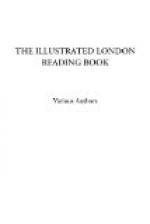* * * * *
ACCORDANCE BETWEEN THE SONGS OF BIRDS AND THE DIFFERENT ASPECTS OF THE DAY.
[Illustration: Letter T.]
There is a beautiful propriety in the order in which Nature seems to have directed the singing-birds to fill up the day with their pleasing harmony. The accordance between their songs and the external aspect of nature, at the successive periods of the day at which they sing, is quite remarkable. And it is impossible to visit the forest or the sequestered dell, where the notes of the feathered tribes are heard to the greatest advantage, without being impressed with the conviction that there is design in the arrangement of this sylvan minstrelsy.—
[Illustration: THE ROBIN.]
First the robin (and not the lark, as has been generally imagined), as soon as twilight has drawn its imperceptible line between night and day, begins his lovely song. How sweetly does this harmonise with the soft dawning of the day! He goes on till the twinkling sun-beams begin to tell him that his notes no longer accord with the rising scene. Up starts the lark, and with him a variety of sprightly songsters, whose lively notes are in perfect correspondence with the gaiety of the morning. The general warbling continues, with now and then an interruption by the transient croak of the raven, the scream of the jay, or the pert chattering of the daw. The nightingale, unwearied by the vocal exertions of the night, joins his inferiors in sound in the general harmony. The thrush is wisely placed on the summit of some lofty tree, that its loud and piercing notes may be softened by distance before they reach the ear; while the mellow blackbird seeks the inferior branches.
[Illustration: THE LARK.]
[Illustration: THE LINNET.]
Should the sun, having been eclipsed by a cloud, shine forth with fresh effulgence, how frequently we see the goldfinch perch on some blossomed bough, and hear its song poured forth in a strain peculiarly energetic; while the sun, full shining on his beautiful plumes, displays his golden wings and crimson crest to charming advantage. The notes of the cuckoo blend with this cheering concert in a pleasing manner, and for a short time are highly grateful to the ear. But sweet as this singular song is, it would tire by its uniformity, were it not given in so transient a manner.
At length evening advances, the performers gradually retire, and the concert softly dies away. The sun is seen no more. The robin again sends up his twilight song, till the more serene hour of night sets him to the bower to rest. And now to close the scene in full and perfect harmony; no sooner is the voice of the robin hushed, and night again spreads in gloom over the horizon, than the owl sends forth his slow and solemn tones. They are more than plaintive and less than melancholy, and tend to inspire the imagination with a train of contemplations well adapted to the serious hour.




